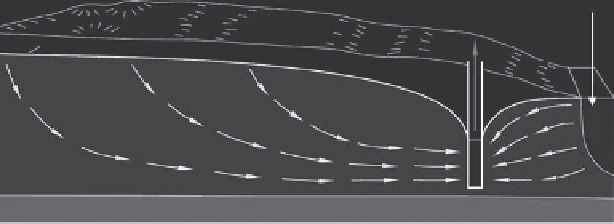Environmental Engineering Reference
In-Depth Information
Stream
Q
2
Unconfined aquifer
Confining unit
FIGURE 3.47
Potential effects of groundwater withdrawal near a stream.
(4) straightening meanders and bends in streams and rivers, and the removal of
bankside vegetation; processes collectively termed
channelization
.
• Canal construction.
• Road construction.
• Landscaping.
• Urban sprawl; the practice of creating an urban landscape equivalent to monocrop
agriculture. Mixed residential, retail, and commercial land use within neighbor-
hoods is replaced by regional malls and large big box retail stores with massive
parking lots.
One of the more notable anthropogenic changes to surface water flow was the reversal
of the flow of the Chicago River in 1900 after completion of the Chicago Sanitary and
Ship Canal. This flow modification made the transport of goods and shipping between the
Great Lakes and Mississippi River possible. Reversing the flow of the river also provided a
clean source of water and changed the local nickname of the river, which had been known
as the “Stinking River” (Friends of the Chicago River 2009).
Withdrawing groundwater close to a surface water body provides another example of
the human influences on surface water flow. In this scenario, pumping large quantities of
groundwater near a surface water source may result in some depletion of water from the
surface water source (Figure 3.47) (Alley et al. 1999). In one case known to the authors, con-
taminated surface water was drawn into drinking water wells as a result of overpumping.
This recently happened in the town of Franklin, Michigan, a rural community located in
the northwestern part of the Rouge River watershed. Drinking water wells located adja-
cent to the Rouge River were drawing river water into the wells and consumed by resi-
dents for several months before the situation was detected and rectified. The consumption
of contaminated drinking water led to a variety of serious intestinal illnesses of several
Franklin residents.
3.7.1.1 Destruction of Wetlands
Wetlands are nature's sponge and filter. They perform the following functions: adsorb-
ing excess water; cleaning and biologically degrading harmful chemicals such as oil and
other petroleum compounds; assisting in keeping lakes and rivers clean and free of excess
sediment; slowing the erosion process; decreasing flooding; and are important areas of
groundwater recharge.

Search WWH ::

Custom Search